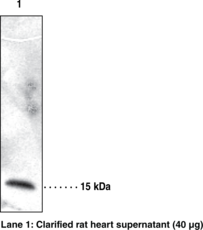Cayman
Showing 14701–14850 of 45550 results
-
Brand:CaymanSKU:600092 - 250 µl
Available on backorder
Brand:CaymanSKU:600615 - 2.5 mlAvailable on backorder
Cell-Based Assay EGCG has been formulated and tested to work with Cayman’s Assay Kits. Detailed instructions for its use are contained in the respective Cayman Assay Kit booklet.
Brand:CaymanSKU:10011096 - 1 eaAvailable on backorder
Brand:CaymanSKU:10009899 - 1 eaAvailable on backorder
Brand:CaymanSKU:600802 - 2 mgAvailable on backorder
Brand:CaymanSKU:600362 - 3 mgAvailable on backorder
Brand:CaymanSKU:600155 - 1 eaAvailable on backorder
Brand:CaymanSKU:600332 - 50 µlAvailable on backorder
Brand:CaymanSKU:600053 - 100 µLAvailable on backorder
Brand:CaymanSKU:600053 - 500 µLAvailable on backorder
Brand:CaymanSKU:600052 - 100 µLAvailable on backorder
Brand:CaymanSKU:600052 - 500 µLAvailable on backorder
Brand:CaymanSKU:600051 - 100 µlAvailable on backorder
Brand:CaymanSKU:10008978 - 1 eaAvailable on backorder
Brand:CaymanSKU:10010215 - 1 eaAvailable on backorder
Brand:CaymanSKU:600361 - 100 µlAvailable on backorder
Brand:CaymanSKU:600621 - 50 µlAvailable on backorder
Brand:CaymanSKU:600622 - 25 µlAvailable on backorder
Brand:CaymanSKU:600441 - 500 µlAvailable on backorder
Brand:CaymanSKU:600471 - 500 µlAvailable on backorder
Brand:CaymanSKU:600612 - 25 mlAvailable on backorder
Brand:CaymanSKU:600055 - 1 eaAvailable on backorder
Brand:CaymanSKU:600322 - 50 µlAvailable on backorder
Brand:CaymanSKU:600096 - 5 eaAvailable on backorder
Brand:CaymanSKU:600093 - 5 eaAvailable on backorder
Brand:CaymanSKU:600095 - 5 eaAvailable on backorder
Brand:CaymanSKU:600744 - 10 mlAvailable on backorder
Brand:CaymanSKU:10009869 - 1 eaAvailable on backorder
Brand:CaymanSKU:600372 - 50 µlAvailable on backorder
Brand:CaymanSKU:10009866 - 1 eaAvailable on backorder
Brand:CaymanSKU:600091 - 5 eaAvailable on backorder
Cellobiosan is an anhydro sugar formed during biofuel production from the fast pyrolysis of wood.{29234}
Brand:CaymanSKU:-Out of stock
Cellobiosan is an anhydro sugar formed during biofuel production from the fast pyrolysis of wood.{29234}
Brand:CaymanSKU:-Out of stock
Cellocidin is an antibiotic originally isolated from S. chibaensis.{36482} It is active against various bacterial strains including M. tuberculosis and against the trypanosomes T. brucei and T. rhodesiense (IC50s = 150 and 30 ng/ml, respectively).{36482,24919} It inhibits proliferation of LCL1 and LCL2 cells transformed by Epstein-Barr virus (EBV), activates the c-Myc and NF-κB pathways in BC3 and LCL1 cells, and induces necrotic cell death in B cells infected with gammaherpes virus.{36480} Cellocidin (100-200 ppm) is protective against bacterial leaf blight in rice plants and inhibits α-ketoglutarate oxidation in X. oryzae, the bacterium that causes leaf blight, when used at a concentration of 1 ppm, suggesting that it inhibits the citric acid cycle.{36481} Formulations containing cellocidin have been used as agricultural pesticides.
Brand:CaymanSKU:23637 - 10 mgAvailable on backorder
Cellocidin is an antibiotic originally isolated from S. chibaensis.{36482} It is active against various bacterial strains including M. tuberculosis and against the trypanosomes T. brucei and T. rhodesiense (IC50s = 150 and 30 ng/ml, respectively).{36482,24919} It inhibits proliferation of LCL1 and LCL2 cells transformed by Epstein-Barr virus (EBV), activates the c-Myc and NF-κB pathways in BC3 and LCL1 cells, and induces necrotic cell death in B cells infected with gammaherpes virus.{36480} Cellocidin (100-200 ppm) is protective against bacterial leaf blight in rice plants and inhibits α-ketoglutarate oxidation in X. oryzae, the bacterium that causes leaf blight, when used at a concentration of 1 ppm, suggesting that it inhibits the citric acid cycle.{36481} Formulations containing cellocidin have been used as agricultural pesticides.
Brand:CaymanSKU:23637 - 25 mgAvailable on backorder
Cellocidin is an antibiotic originally isolated from S. chibaensis.{36482} It is active against various bacterial strains including M. tuberculosis and against the trypanosomes T. brucei and T. rhodesiense (IC50s = 150 and 30 ng/ml, respectively).{36482,24919} It inhibits proliferation of LCL1 and LCL2 cells transformed by Epstein-Barr virus (EBV), activates the c-Myc and NF-κB pathways in BC3 and LCL1 cells, and induces necrotic cell death in B cells infected with gammaherpes virus.{36480} Cellocidin (100-200 ppm) is protective against bacterial leaf blight in rice plants and inhibits α-ketoglutarate oxidation in X. oryzae, the bacterium that causes leaf blight, when used at a concentration of 1 ppm, suggesting that it inhibits the citric acid cycle.{36481} Formulations containing cellocidin have been used as agricultural pesticides.
Brand:CaymanSKU:23637 - 5 mgAvailable on backorder
Cellocidin is an antibiotic originally isolated from S. chibaensis.{36482} It is active against various bacterial strains including M. tuberculosis and against the trypanosomes T. brucei and T. rhodesiense (IC50s = 150 and 30 ng/ml, respectively).{36482,24919} It inhibits proliferation of LCL1 and LCL2 cells transformed by Epstein-Barr virus (EBV), activates the c-Myc and NF-κB pathways in BC3 and LCL1 cells, and induces necrotic cell death in B cells infected with gammaherpes virus.{36480} Cellocidin (100-200 ppm) is protective against bacterial leaf blight in rice plants and inhibits α-ketoglutarate oxidation in X. oryzae, the bacterium that causes leaf blight, when used at a concentration of 1 ppm, suggesting that it inhibits the citric acid cycle.{36481} Formulations containing cellocidin have been used as agricultural pesticides.
Brand:CaymanSKU:23637 - 50 mgAvailable on backorder
Retinol is an essential micronutrient that plays a critical role in various physiological functions including cell growth and differentiation. Due to the instability and low solubility of retinol in the aqueous medium, it requires specific binding proteins in body fluids and within the cell for transport.{14372} Cytoplasmic carriers of the retinol molecule, the cellular retinol-binding proteins (CRBPs), are monomeric proteins of about 15 kDa. cRBP7 is the most recently indentified cellular retinol carrier found to be expressed mainly in the kidney, heart, and transverse colon in humans.{13310} In addition to the intracellular transport role of cRBR7, further study of this protein is warranted. Cayman · s cRBP7 polyclonal antibody detects both the mature protein at about 15 kDa by western blot in tissues/cells such as heart, HEK 293 cells, COS-7 cells, and RAW 264.7 cells. The antibody can also be used for immunocytochemistry.
Brand:CaymanSKU:10010250 - 1 eaAvailable on backorder
Antigen: synthetic peptide from human cRBP7 amino acids 125-134 (QVCKQTFQRA) · Host: rabbit · Cross Reactivity: (+) human, mouse, rat, and African green monkey cRBP7; other species not tested · Applications: WB and IHC
Brand:CaymanSKU:10010250- 1 eaAvailable on backorder
Antigen: synthetic peptide from human cRBP7 amino acids 125-134 (QVCKQTFQRA) · Host: rabbit · Cross Reactivity: (+) human, mouse, rat, and African green monkey cRBP7; other species not tested · Applications: WB and IHC
Brand:CaymanSKU:10010250- 1 eaCeMMEC1 is an N-methylisoquinolinone that inhibits the second bromodomain of TAF1 (Kd = 1.8 µM; IC50 = 0.9 µM).{31547} It does not bind to either the first or second bromodomain of BRD4.{31547} This compound synergizes with (+)-JQ1 (Item No. 11187) to inhibit the proliferation of THP-1 and H23 lung adenocarcinoma cells.{31547}
Brand:CaymanSKU:19956 -Available on backorder
CeMMEC1 is an N-methylisoquinolinone that inhibits the second bromodomain of TAF1 (Kd = 1.8 µM; IC50 = 0.9 µM).{31547} It does not bind to either the first or second bromodomain of BRD4.{31547} This compound synergizes with (+)-JQ1 (Item No. 11187) to inhibit the proliferation of THP-1 and H23 lung adenocarcinoma cells.{31547}
Brand:CaymanSKU:19956 -Available on backorder
CeMMEC1 is an N-methylisoquinolinone that inhibits the second bromodomain of TAF1 (Kd = 1.8 µM; IC50 = 0.9 µM).{31547} It does not bind to either the first or second bromodomain of BRD4.{31547} This compound synergizes with (+)-JQ1 (Item No. 11187) to inhibit the proliferation of THP-1 and H23 lung adenocarcinoma cells.{31547}
Brand:CaymanSKU:19956 -Available on backorder
CeMMEC1 is an N-methylisoquinolinone that inhibits the second bromodomain of TAF1 (Kd = 1.8 µM; IC50 = 0.9 µM).{31547} It does not bind to either the first or second bromodomain of BRD4.{31547} This compound synergizes with (+)-JQ1 (Item No. 11187) to inhibit the proliferation of THP-1 and H23 lung adenocarcinoma cells.{31547}
Brand:CaymanSKU:19956 -Available on backorder
CeMMEC13 is an isoquinolinone that selectively inhibits the second bromodomain of TAF1 (IC50 = 2.1 µM).{31547} It does not bind to bromodomains of BRD4, BRD9, or CREBBP.{31547} CeMMEC13 synergizes with (+)-JQ1 (Item No. 11187) to inhibit the proliferation of THP-1 and H23 lung adenocarcinoma cells.{31547}
Brand:CaymanSKU:20224 -Available on backorder
CeMMEC13 is an isoquinolinone that selectively inhibits the second bromodomain of TAF1 (IC50 = 2.1 µM).{31547} It does not bind to bromodomains of BRD4, BRD9, or CREBBP.{31547} CeMMEC13 synergizes with (+)-JQ1 (Item No. 11187) to inhibit the proliferation of THP-1 and H23 lung adenocarcinoma cells.{31547}
Brand:CaymanSKU:20224 -Available on backorder
CeMMEC13 is an isoquinolinone that selectively inhibits the second bromodomain of TAF1 (IC50 = 2.1 µM).{31547} It does not bind to bromodomains of BRD4, BRD9, or CREBBP.{31547} CeMMEC13 synergizes with (+)-JQ1 (Item No. 11187) to inhibit the proliferation of THP-1 and H23 lung adenocarcinoma cells.{31547}
Brand:CaymanSKU:20224 -Available on backorder
CeMMEC13 is an isoquinolinone that selectively inhibits the second bromodomain of TAF1 (IC50 = 2.1 µM).{31547} It does not bind to bromodomains of BRD4, BRD9, or CREBBP.{31547} CeMMEC13 synergizes with (+)-JQ1 (Item No. 11187) to inhibit the proliferation of THP-1 and H23 lung adenocarcinoma cells.{31547}
Brand:CaymanSKU:20224 -Available on backorder
Cenerimod is a sphingosine-1-phosphate receptor 1 (S1P1) modulator with an EC50 value of 1 nM in a [35S]GTPɣS binding assay.{52269} It is selective for S1P1 over S1P2, -3, -4, and -5 (EC50s = >10,000, 228, 2,137, and 36 nM, respectively). Cenerimod (5 µM) decreases TGF-β-induced increases in collagen levels in primary mouse skin fibroblasts.{52270} It inhibits CD4+ T cell, CD8+ T cell, and CD11b+ cell infiltration, reduces IL1b, Il6, and Il13 expression, as well as decreases fibrosis in the skin of a mouse model of sclerodermatous chronic graft versus host disease induced by allogenic bone marrow transplant when administered at a dose of 10 mg/kg per day. Cenerimod (6 mg/kg per day for 32 days) reduces paralysis and spinal cord demyelination in a mouse model of experimental autoimmune encephalitis (EAE).
Brand:CaymanSKU:29665 - 10 mgAvailable on backorder
Cenerimod is a sphingosine-1-phosphate receptor 1 (S1P1) modulator with an EC50 value of 1 nM in a [35S]GTPɣS binding assay.{52269} It is selective for S1P1 over S1P2, -3, -4, and -5 (EC50s = >10,000, 228, 2,137, and 36 nM, respectively). Cenerimod (5 µM) decreases TGF-β-induced increases in collagen levels in primary mouse skin fibroblasts.{52270} It inhibits CD4+ T cell, CD8+ T cell, and CD11b+ cell infiltration, reduces IL1b, Il6, and Il13 expression, as well as decreases fibrosis in the skin of a mouse model of sclerodermatous chronic graft versus host disease induced by allogenic bone marrow transplant when administered at a dose of 10 mg/kg per day. Cenerimod (6 mg/kg per day for 32 days) reduces paralysis and spinal cord demyelination in a mouse model of experimental autoimmune encephalitis (EAE).
Brand:CaymanSKU:29665 - 25 mgAvailable on backorder
Cenerimod is a sphingosine-1-phosphate receptor 1 (S1P1) modulator with an EC50 value of 1 nM in a [35S]GTPɣS binding assay.{52269} It is selective for S1P1 over S1P2, -3, -4, and -5 (EC50s = >10,000, 228, 2,137, and 36 nM, respectively). Cenerimod (5 µM) decreases TGF-β-induced increases in collagen levels in primary mouse skin fibroblasts.{52270} It inhibits CD4+ T cell, CD8+ T cell, and CD11b+ cell infiltration, reduces IL1b, Il6, and Il13 expression, as well as decreases fibrosis in the skin of a mouse model of sclerodermatous chronic graft versus host disease induced by allogenic bone marrow transplant when administered at a dose of 10 mg/kg per day. Cenerimod (6 mg/kg per day for 32 days) reduces paralysis and spinal cord demyelination in a mouse model of experimental autoimmune encephalitis (EAE).
Brand:CaymanSKU:29665 - 5 mgAvailable on backorder
Cenicriviroc is an orally bioavailable antagonist of C-C chemokine receptor type 5 (CCR5) and CCR2 that inhibits binding of macrophage inflammatory protein 1α (MIP-1α; IC50 = 2.3 nM) and monocyte chemotactic protein 1 (MCP-1; IC50 = 5.9 nM), respectively, in CHO cells.{41586} Cenicriviroc is also an antagonist of CCR3 and CCR4 (IC50s = 2.4 and 1.1 μM, respectively), however, it does not inhibit agonist binding to CCR1 or CCR7 at concentrations up to 10 μM. At a concentration of 100 nM, cenicriviroc completely inhibits replication of R5 HIV-1 in U87.CD4.CCR5 cells. Cenicriviroc inhibits replication of the R5 HIV-1 strains JR-FL and KK in peripheral blood mononuclear cells (PBMCs) with EC50 values ranging from 21 to 210 pM and 33 to 91 pM, respectively. In vivo, cenicriviroc (20 mg/kg per day) reduces collagen deposition, levels of collagen type 1 protein and mRNA expression, and non-alcoholic fatty liver disease activity score in a mouse model of non-alcoholic steatohepatitis (NASH).{41587} It also reduces collagen type 1 protein levels, mRNA expression, and collagen deposition in a mouse model of unilateral ureter obstruction and a rat model of thioacetamide-induced liver fibrosis.
Brand:CaymanSKU:23927 - 1 mgAvailable on backorder
Cenicriviroc is an orally bioavailable antagonist of C-C chemokine receptor type 5 (CCR5) and CCR2 that inhibits binding of macrophage inflammatory protein 1α (MIP-1α; IC50 = 2.3 nM) and monocyte chemotactic protein 1 (MCP-1; IC50 = 5.9 nM), respectively, in CHO cells.{41586} Cenicriviroc is also an antagonist of CCR3 and CCR4 (IC50s = 2.4 and 1.1 μM, respectively), however, it does not inhibit agonist binding to CCR1 or CCR7 at concentrations up to 10 μM. At a concentration of 100 nM, cenicriviroc completely inhibits replication of R5 HIV-1 in U87.CD4.CCR5 cells. Cenicriviroc inhibits replication of the R5 HIV-1 strains JR-FL and KK in peripheral blood mononuclear cells (PBMCs) with EC50 values ranging from 21 to 210 pM and 33 to 91 pM, respectively. In vivo, cenicriviroc (20 mg/kg per day) reduces collagen deposition, levels of collagen type 1 protein and mRNA expression, and non-alcoholic fatty liver disease activity score in a mouse model of non-alcoholic steatohepatitis (NASH).{41587} It also reduces collagen type 1 protein levels, mRNA expression, and collagen deposition in a mouse model of unilateral ureter obstruction and a rat model of thioacetamide-induced liver fibrosis.
Brand:CaymanSKU:23927 - 10 mgAvailable on backorder
Cenicriviroc is an orally bioavailable antagonist of C-C chemokine receptor type 5 (CCR5) and CCR2 that inhibits binding of macrophage inflammatory protein 1α (MIP-1α; IC50 = 2.3 nM) and monocyte chemotactic protein 1 (MCP-1; IC50 = 5.9 nM), respectively, in CHO cells.{41586} Cenicriviroc is also an antagonist of CCR3 and CCR4 (IC50s = 2.4 and 1.1 μM, respectively), however, it does not inhibit agonist binding to CCR1 or CCR7 at concentrations up to 10 μM. At a concentration of 100 nM, cenicriviroc completely inhibits replication of R5 HIV-1 in U87.CD4.CCR5 cells. Cenicriviroc inhibits replication of the R5 HIV-1 strains JR-FL and KK in peripheral blood mononuclear cells (PBMCs) with EC50 values ranging from 21 to 210 pM and 33 to 91 pM, respectively. In vivo, cenicriviroc (20 mg/kg per day) reduces collagen deposition, levels of collagen type 1 protein and mRNA expression, and non-alcoholic fatty liver disease activity score in a mouse model of non-alcoholic steatohepatitis (NASH).{41587} It also reduces collagen type 1 protein levels, mRNA expression, and collagen deposition in a mouse model of unilateral ureter obstruction and a rat model of thioacetamide-induced liver fibrosis.
Brand:CaymanSKU:23927 - 5 mgAvailable on backorder
Cenicriviroc is an orally bioavailable antagonist of C-C chemokine receptor type 5 (CCR5) and CCR2 that inhibits binding of macrophage inflammatory protein 1α (MIP-1α; IC50 = 2.3 nM) and monocyte chemotactic protein 1 (MCP-1; IC50 = 5.9 nM), respectively, in CHO cells.{41586} Cenicriviroc is also an antagonist of CCR3 and CCR4 (IC50s = 2.4 and 1.1 μM, respectively), however, it does not inhibit agonist binding to CCR1 or CCR7 at concentrations up to 10 μM. At a concentration of 100 nM, cenicriviroc completely inhibits replication of R5 HIV-1 in U87.CD4.CCR5 cells. Cenicriviroc inhibits replication of the R5 HIV-1 strains JR-FL and KK in peripheral blood mononuclear cells (PBMCs) with EC50 values ranging from 21 to 210 pM and 33 to 91 pM, respectively. In vivo, cenicriviroc (20 mg/kg per day) reduces collagen deposition, levels of collagen type 1 protein and mRNA expression, and non-alcoholic fatty liver disease activity score in a mouse model of non-alcoholic steatohepatitis (NASH).{41587} It also reduces collagen type 1 protein levels, mRNA expression, and collagen deposition in a mouse model of unilateral ureter obstruction and a rat model of thioacetamide-induced liver fibrosis.
Brand:CaymanSKU:23927 - 500 µgAvailable on backorder
CENTA is a colorimetric cephalosporin substrate for β-lactamases.{58099,58100} Upon hydrolysis by β-lacatamases, CENTA turns from light yellow to chrome yellow, which can be quantified by colorimetric detection at 405 nm as a measure of β-lactamase activity.
Brand:CaymanSKU:31534 - 1 mgAvailable on backorder
CENTA is a colorimetric cephalosporin substrate for β-lactamases.{58099,58100} Upon hydrolysis by β-lacatamases, CENTA turns from light yellow to chrome yellow, which can be quantified by colorimetric detection at 405 nm as a measure of β-lactamase activity.
Brand:CaymanSKU:31534 - 5 mgAvailable on backorder
CEP-28122 is a potent inhibitor of anaplastic lymphoma kinase (ALK; IC50 = 1.9 nM) that less potently inhibits other tyrosine and serine/threonine kinases.{31619} It blocks the phosphorylation of ALK and other ALK substrates in cells and induces concentration-dependent growth inhibition or cytotoxicity of ALK-positive cancer cells.{31619} CEP-28122 is orally active, inhibiting ALK tyrosine phosphorylation in tumor xenografts in mice for more than 12 hours following single oral dosing at 30 mg/kg.{31619}
Brand:CaymanSKU:-Available on backorder
CEP-28122 is a potent inhibitor of anaplastic lymphoma kinase (ALK; IC50 = 1.9 nM) that less potently inhibits other tyrosine and serine/threonine kinases.{31619} It blocks the phosphorylation of ALK and other ALK substrates in cells and induces concentration-dependent growth inhibition or cytotoxicity of ALK-positive cancer cells.{31619} CEP-28122 is orally active, inhibiting ALK tyrosine phosphorylation in tumor xenografts in mice for more than 12 hours following single oral dosing at 30 mg/kg.{31619}
Brand:CaymanSKU:-Available on backorder
CEP-28122 is a potent inhibitor of anaplastic lymphoma kinase (ALK; IC50 = 1.9 nM) that less potently inhibits other tyrosine and serine/threonine kinases.{31619} It blocks the phosphorylation of ALK and other ALK substrates in cells and induces concentration-dependent growth inhibition or cytotoxicity of ALK-positive cancer cells.{31619} CEP-28122 is orally active, inhibiting ALK tyrosine phosphorylation in tumor xenografts in mice for more than 12 hours following single oral dosing at 30 mg/kg.{31619}
Brand:CaymanSKU:-Available on backorder
CEP-28122 is a potent inhibitor of anaplastic lymphoma kinase (ALK; IC50 = 1.9 nM) that less potently inhibits other tyrosine and serine/threonine kinases.{31619} It blocks the phosphorylation of ALK and other ALK substrates in cells and induces concentration-dependent growth inhibition or cytotoxicity of ALK-positive cancer cells.{31619} CEP-28122 is orally active, inhibiting ALK tyrosine phosphorylation in tumor xenografts in mice for more than 12 hours following single oral dosing at 30 mg/kg.{31619}
Brand:CaymanSKU:-Available on backorder
B-Raf is a MAP kinase kinase kinase, which functions downstream of Ras family GTPases to activate MEK1/2 and ERK1/2 signaling.{27148} Mutations of B-Raf, particularly at Val600, are common in melanomas and melanocytic nevi.{27148} CEP-32496 is a potent inhibitor of B-RafV600E (Kd = 14 nM in an in vitro binding assay).{30907} It blocks B-RafV600E-dependent phosphorylation of MEK in human melanoma A375 and colorectal cancer COLO 205 cells (IC50s = 78 and 60 nM, respectively).{30907} CEP-32496 binds kinases other than B-Raf but displays selective cytotoxicity for cells expressing B-RafV600E.{30907} It displays good oral bioavailability in rats, dogs, and monkeys and has single oral dose pharmacodynamics inhibition of both pMEK and pERK in B-RafV600E colon carcinoma xenografts in nude mice.{30907}
Brand:CaymanSKU:-Available on backorder
B-Raf is a MAP kinase kinase kinase, which functions downstream of Ras family GTPases to activate MEK1/2 and ERK1/2 signaling.{27148} Mutations of B-Raf, particularly at Val600, are common in melanomas and melanocytic nevi.{27148} CEP-32496 is a potent inhibitor of B-RafV600E (Kd = 14 nM in an in vitro binding assay).{30907} It blocks B-RafV600E-dependent phosphorylation of MEK in human melanoma A375 and colorectal cancer COLO 205 cells (IC50s = 78 and 60 nM, respectively).{30907} CEP-32496 binds kinases other than B-Raf but displays selective cytotoxicity for cells expressing B-RafV600E.{30907} It displays good oral bioavailability in rats, dogs, and monkeys and has single oral dose pharmacodynamics inhibition of both pMEK and pERK in B-RafV600E colon carcinoma xenografts in nude mice.{30907}
Brand:CaymanSKU:-Available on backorder
B-Raf is a MAP kinase kinase kinase, which functions downstream of Ras family GTPases to activate MEK1/2 and ERK1/2 signaling.{27148} Mutations of B-Raf, particularly at Val600, are common in melanomas and melanocytic nevi.{27148} CEP-32496 is a potent inhibitor of B-RafV600E (Kd = 14 nM in an in vitro binding assay).{30907} It blocks B-RafV600E-dependent phosphorylation of MEK in human melanoma A375 and colorectal cancer COLO 205 cells (IC50s = 78 and 60 nM, respectively).{30907} CEP-32496 binds kinases other than B-Raf but displays selective cytotoxicity for cells expressing B-RafV600E.{30907} It displays good oral bioavailability in rats, dogs, and monkeys and has single oral dose pharmacodynamics inhibition of both pMEK and pERK in B-RafV600E colon carcinoma xenografts in nude mice.{30907}
Brand:CaymanSKU:-Available on backorder
B-Raf is a MAP kinase kinase kinase, which functions downstream of Ras family GTPases to activate MEK1/2 and ERK1/2 signaling.{27148} Mutations of B-Raf, particularly at Val600, are common in melanomas and melanocytic nevi.{27148} CEP-32496 is a potent inhibitor of B-RafV600E (Kd = 14 nM in an in vitro binding assay).{30907} It blocks B-RafV600E-dependent phosphorylation of MEK in human melanoma A375 and colorectal cancer COLO 205 cells (IC50s = 78 and 60 nM, respectively).{30907} CEP-32496 binds kinases other than B-Raf but displays selective cytotoxicity for cells expressing B-RafV600E.{30907} It displays good oral bioavailability in rats, dogs, and monkeys and has single oral dose pharmacodynamics inhibition of both pMEK and pERK in B-RafV600E colon carcinoma xenografts in nude mice.{30907}
Brand:CaymanSKU:-Available on backorder
Janus kinases (JAKs) are non-receptor kinases that mediate signaling through cytokine receptors, often to members of the signal transducer and activator of transcription family.{20362} CEP-33779 is a potent, orally available inhibitor of JAK2 (IC50 = 1.3 nM).{27702} It shows 65-fold selectivity for JAK2 over JAK3.{27702} In mouse models of systemic lupus erythematosus, CEP-33779 reduces the production of inflammatory cytokines, decreases splenomegaly and lymphomegaly, and extends survival.{27702} It also diminishes inflammatory signaling and improves clinical scores in mice during collagen antibody-induced arthritis and collagen type II-induced arthritis.{27701} CEP-33779 induces regression of established colorectal tumors in mice, reducing angiogenesis and proliferation of tumor cells.{27700}
Brand:CaymanSKU:-Out of stock
Janus kinases (JAKs) are non-receptor kinases that mediate signaling through cytokine receptors, often to members of the signal transducer and activator of transcription family.{20362} CEP-33779 is a potent, orally available inhibitor of JAK2 (IC50 = 1.3 nM).{27702} It shows 65-fold selectivity for JAK2 over JAK3.{27702} In mouse models of systemic lupus erythematosus, CEP-33779 reduces the production of inflammatory cytokines, decreases splenomegaly and lymphomegaly, and extends survival.{27702} It also diminishes inflammatory signaling and improves clinical scores in mice during collagen antibody-induced arthritis and collagen type II-induced arthritis.{27701} CEP-33779 induces regression of established colorectal tumors in mice, reducing angiogenesis and proliferation of tumor cells.{27700}
Brand:CaymanSKU:-Out of stock
Janus kinases (JAKs) are non-receptor kinases that mediate signaling through cytokine receptors, often to members of the signal transducer and activator of transcription family.{20362} CEP-33779 is a potent, orally available inhibitor of JAK2 (IC50 = 1.3 nM).{27702} It shows 65-fold selectivity for JAK2 over JAK3.{27702} In mouse models of systemic lupus erythematosus, CEP-33779 reduces the production of inflammatory cytokines, decreases splenomegaly and lymphomegaly, and extends survival.{27702} It also diminishes inflammatory signaling and improves clinical scores in mice during collagen antibody-induced arthritis and collagen type II-induced arthritis.{27701} CEP-33779 induces regression of established colorectal tumors in mice, reducing angiogenesis and proliferation of tumor cells.{27700}
Brand:CaymanSKU:-Out of stock
CEP-37440 is a dual inhibitor of focal adhesion kinase 1 (FAK1; IC50s = 2.0 and 80 nM for in vitro enzyme and cellular inhibition, respectively) and anaplastic lymphoma kinase (ALK; IC50s = 3.1 and 22 nM for in vitro enzyme and cellular inhibition, respectively).{33407,33408} It blocks the proliferation of inflammatory and triple-negative breast cancer cell lines but not normal breast epithelial cells.{33408} CEP-37440 reduces the growth and metastasis of breast cancer xenografts in mice when given by oral gavage.{33408}
Brand:CaymanSKU:21278 -Out of stock
CEP-37440 is a dual inhibitor of focal adhesion kinase 1 (FAK1; IC50s = 2.0 and 80 nM for in vitro enzyme and cellular inhibition, respectively) and anaplastic lymphoma kinase (ALK; IC50s = 3.1 and 22 nM for in vitro enzyme and cellular inhibition, respectively).{33407,33408} It blocks the proliferation of inflammatory and triple-negative breast cancer cell lines but not normal breast epithelial cells.{33408} CEP-37440 reduces the growth and metastasis of breast cancer xenografts in mice when given by oral gavage.{33408}
Brand:CaymanSKU:21278 -Out of stock
CEP-37440 is a dual inhibitor of focal adhesion kinase 1 (FAK1; IC50s = 2.0 and 80 nM for in vitro enzyme and cellular inhibition, respectively) and anaplastic lymphoma kinase (ALK; IC50s = 3.1 and 22 nM for in vitro enzyme and cellular inhibition, respectively).{33407,33408} It blocks the proliferation of inflammatory and triple-negative breast cancer cell lines but not normal breast epithelial cells.{33408} CEP-37440 reduces the growth and metastasis of breast cancer xenografts in mice when given by oral gavage.{33408}
Brand:CaymanSKU:21278 -Out of stock
CEP-37440 is a dual inhibitor of focal adhesion kinase 1 (FAK1; IC50s = 2.0 and 80 nM for in vitro enzyme and cellular inhibition, respectively) and anaplastic lymphoma kinase (ALK; IC50s = 3.1 and 22 nM for in vitro enzyme and cellular inhibition, respectively).{33407,33408} It blocks the proliferation of inflammatory and triple-negative breast cancer cell lines but not normal breast epithelial cells.{33408} CEP-37440 reduces the growth and metastasis of breast cancer xenografts in mice when given by oral gavage.{33408}
Brand:CaymanSKU:21278 -Out of stock
CEP-40783 is an inhibitor of the receptor tyrosine kinases Axl and c-MET (IC50s = 7 and 12 nM, respectively).{43937} It inhibits Axl in 293GT cells expressing Axl and c-MET in NCI H1299 non-small cell lung cancer (NSCLC) cells with IC50 values of 0.26 and 6 nM, respectively. It also inhibits the receptor tyrosine kinases TYRO3 and MER (IC50s = 3.5 and 1.89 nM, respectively).{43938} CEP-40783 (0.3 mg/kg) induces complete regression of tumors in an Axl/NIH3T3 mouse xenograft model and reduces the metastatic tumor burden in mouse orthotopic breast cancer models. It also induces tumor stasis and regression in an EBC-1 NSCLC mouse xenograft model when administered at doses of 3 and 10 mg/kg, respectively. CEP-40783 reduces tumor growth in an MC38 mouse syngeneic model concomitantly with an increase in leukocyte infiltration into tumors, the production of IFN-γ in natural killer cells, and the percentage of CD8+ T cells in tumor tissue.{43938}
Brand:CaymanSKU:25749 - 1 mgAvailable on backorder
CEP-40783 is an inhibitor of the receptor tyrosine kinases Axl and c-MET (IC50s = 7 and 12 nM, respectively).{43937} It inhibits Axl in 293GT cells expressing Axl and c-MET in NCI H1299 non-small cell lung cancer (NSCLC) cells with IC50 values of 0.26 and 6 nM, respectively. It also inhibits the receptor tyrosine kinases TYRO3 and MER (IC50s = 3.5 and 1.89 nM, respectively).{43938} CEP-40783 (0.3 mg/kg) induces complete regression of tumors in an Axl/NIH3T3 mouse xenograft model and reduces the metastatic tumor burden in mouse orthotopic breast cancer models. It also induces tumor stasis and regression in an EBC-1 NSCLC mouse xenograft model when administered at doses of 3 and 10 mg/kg, respectively. CEP-40783 reduces tumor growth in an MC38 mouse syngeneic model concomitantly with an increase in leukocyte infiltration into tumors, the production of IFN-γ in natural killer cells, and the percentage of CD8+ T cells in tumor tissue.{43938}
Brand:CaymanSKU:25749 - 10 mgAvailable on backorder
CEP-40783 is an inhibitor of the receptor tyrosine kinases Axl and c-MET (IC50s = 7 and 12 nM, respectively).{43937} It inhibits Axl in 293GT cells expressing Axl and c-MET in NCI H1299 non-small cell lung cancer (NSCLC) cells with IC50 values of 0.26 and 6 nM, respectively. It also inhibits the receptor tyrosine kinases TYRO3 and MER (IC50s = 3.5 and 1.89 nM, respectively).{43938} CEP-40783 (0.3 mg/kg) induces complete regression of tumors in an Axl/NIH3T3 mouse xenograft model and reduces the metastatic tumor burden in mouse orthotopic breast cancer models. It also induces tumor stasis and regression in an EBC-1 NSCLC mouse xenograft model when administered at doses of 3 and 10 mg/kg, respectively. CEP-40783 reduces tumor growth in an MC38 mouse syngeneic model concomitantly with an increase in leukocyte infiltration into tumors, the production of IFN-γ in natural killer cells, and the percentage of CD8+ T cells in tumor tissue.{43938}
Brand:CaymanSKU:25749 - 25 mgAvailable on backorder
CEP-40783 is an inhibitor of the receptor tyrosine kinases Axl and c-MET (IC50s = 7 and 12 nM, respectively).{43937} It inhibits Axl in 293GT cells expressing Axl and c-MET in NCI H1299 non-small cell lung cancer (NSCLC) cells with IC50 values of 0.26 and 6 nM, respectively. It also inhibits the receptor tyrosine kinases TYRO3 and MER (IC50s = 3.5 and 1.89 nM, respectively).{43938} CEP-40783 (0.3 mg/kg) induces complete regression of tumors in an Axl/NIH3T3 mouse xenograft model and reduces the metastatic tumor burden in mouse orthotopic breast cancer models. It also induces tumor stasis and regression in an EBC-1 NSCLC mouse xenograft model when administered at doses of 3 and 10 mg/kg, respectively. CEP-40783 reduces tumor growth in an MC38 mouse syngeneic model concomitantly with an increase in leukocyte infiltration into tumors, the production of IFN-γ in natural killer cells, and the percentage of CD8+ T cells in tumor tissue.{43938}
Brand:CaymanSKU:25749 - 5 mgAvailable on backorder
Cephaeline is an alkaloid originally isolated from C. ipecacuanha with diverse biological activities.{36703,36704,36705,36706} It inhibits the cytochrome P450 (CYP) isoforms CYP2D6 and CYP3A4 in vitro (Kis = 54 and 355 μM, respectively).{36703} Cephaeline reduces Zika virus (ZIKV) NS1 protein expression in HEK293 cells (IC50 = 26.4 nM) and reduces viral titer in ZIKV-infected SNB-19 cells (IC50 = 3.11 nM).{36704} In vivo, cephaeline (2 mg/kg, i.p.) reduces serum viral load in ZIKV-infected Ifnar1-/- mice. It induces emesis in ferrets when administered at a dose of 0.5 mg/kg, an effect that is prevented by the serotonin (5-HT) receptor subtype 5-HT3 antagonist ondansetron.{36705} Cephaeline (1 mg/kg) also increases output of respiratory tract fluid in rabbits.{36706}
Brand:CaymanSKU:20916 -Out of stock
Cephaeline is an alkaloid originally isolated from C. ipecacuanha with diverse biological activities.{36703,36704,36705,36706} It inhibits the cytochrome P450 (CYP) isoforms CYP2D6 and CYP3A4 in vitro (Kis = 54 and 355 μM, respectively).{36703} Cephaeline reduces Zika virus (ZIKV) NS1 protein expression in HEK293 cells (IC50 = 26.4 nM) and reduces viral titer in ZIKV-infected SNB-19 cells (IC50 = 3.11 nM).{36704} In vivo, cephaeline (2 mg/kg, i.p.) reduces serum viral load in ZIKV-infected Ifnar1-/- mice. It induces emesis in ferrets when administered at a dose of 0.5 mg/kg, an effect that is prevented by the serotonin (5-HT) receptor subtype 5-HT3 antagonist ondansetron.{36705} Cephaeline (1 mg/kg) also increases output of respiratory tract fluid in rabbits.{36706}
Brand:CaymanSKU:20916 -Out of stock
Cephalexin is a cephalosporin antibiotic that is active against most Gram-positive cocci, including penicillinase-producing Staphylococci, and against Gram-negative bacteria such as N. gonorrhoeae, E. coli, K. pneumonia, Salmonellae, Shigella, and some strains of H. influenza.{27468} It is not effective against Proteus species, Pseudomonas, or mycobacteria.{27468} Cephalexin specifically inactivates penicillin-binding protein (PBP) 3, which is essential for bacterial cell wall synthesis.{25731} It has been combined with antibiotics that preferentially target alternate PBP isotypes as a strategy to combat drug-resistant bacteria.{26293}
Brand:CaymanSKU:9002009 - 1 gAvailable on backorder
Cephalexin is a cephalosporin antibiotic that is active against most Gram-positive cocci, including penicillinase-producing Staphylococci, and against Gram-negative bacteria such as N. gonorrhoeae, E. coli, K. pneumonia, Salmonellae, Shigella, and some strains of H. influenza.{27468} It is not effective against Proteus species, Pseudomonas, or mycobacteria.{27468} Cephalexin specifically inactivates penicillin-binding protein (PBP) 3, which is essential for bacterial cell wall synthesis.{25731} It has been combined with antibiotics that preferentially target alternate PBP isotypes as a strategy to combat drug-resistant bacteria.{26293}
Brand:CaymanSKU:9002009 - 10 gAvailable on backorder
Cephalexin is a cephalosporin antibiotic that is active against most Gram-positive cocci, including penicillinase-producing Staphylococci, and against Gram-negative bacteria such as N. gonorrhoeae, E. coli, K. pneumonia, Salmonellae, Shigella, and some strains of H. influenza.{27468} It is not effective against Proteus species, Pseudomonas, or mycobacteria.{27468} Cephalexin specifically inactivates penicillin-binding protein (PBP) 3, which is essential for bacterial cell wall synthesis.{25731} It has been combined with antibiotics that preferentially target alternate PBP isotypes as a strategy to combat drug-resistant bacteria.{26293}
Brand:CaymanSKU:9002009 - 25 gAvailable on backorder






![An S1P1 modulator (EC50 = 1 nM in a [35S]GTPɣS binding assay); selective for S1P1 over S1P2](https://interpriseusa.com/wp-content/uploads/2021/06/29665.png)








